英语1基础模块第六单元教学设计方案
- 格式:doc
- 大小:373.50 KB
- 文档页数:21

教师学科教案[20 -20学年度第—学期]任教学科:________________ 任教年级:________________ 任教老师:________________xx市实验学校r \・•- 二〕r——题: 材: 门: 名: Teach ing Desig n :崇阳职业技术教育中心 机电部 XI7. Would you like to order 英语1 (基础模块)1.Teaching aims1.1 Knowledge aims: learning the vocabulary and structures of this unit1.1.1 Vocabularymanager, fork, menu, customer, chopsticks, juice, coffee, beef and so on1.1.2 Grammar focusthe Comparative and Superlative form of adjectives1.2 Ability aims1.2.1 Ss are able to describe and compare different things both in written andoral English;1.2.2 Ss are able to classify words about restaurant and write down the menu.1.2.3 Ss are able to improve comprehensive skills through tasks1.3 Emotional aimsSs are able to take an active part in cooperation with teammates to finish tasks;Ss are able to make choice through comparison2. Teaching key pointsGeneralizing the rules of the Comparatives and Superlatives; consolidate the words in this unit in specific context3. Possible difficultyGetting familiar with Comparatives and Superlatives according to pictures;4. Teaching and learning methods4.1 teaching methods communicative teaching method audio-visual method4.2 learning methodscommunicative strategyresource strategy5. Teaching toolsMulti-media; PPT; chalks6. Teaching proceduresStep One Review &Lead inFirst teacher will brainstorm students with a video to help them have a review what have been learnt before, and then shows two pictures to lead in the topic of this lesson.Step Two Grammar focus1. Recognize the rulesTeacher classifies in advance the table on Page 95 into five sections according to the five regular changing rules. In order to cultivate students'interest, teacher plays a cliff video. And then teacher shows tables respectively to let students generalize the rules of the different degrees of adjectives: Positive degree, Comparative degree and Superlative degree. Then teacher summarizes the usage of adjective degrees.(说明:以一个视频片段引起学生学习兴趣。
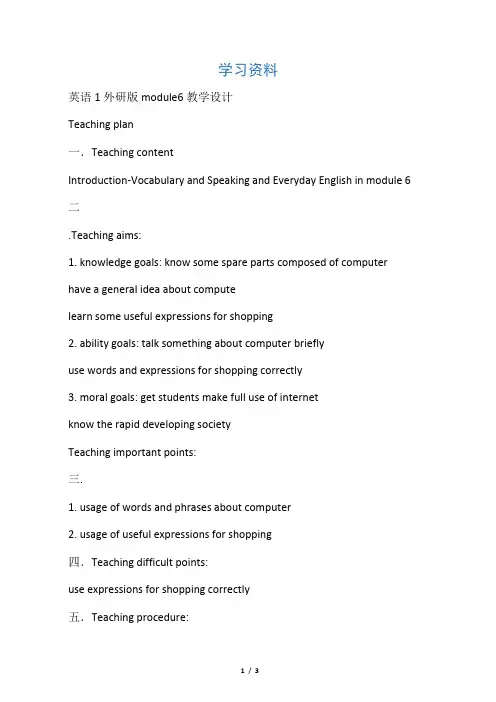
学习资料英语1外研版module6教学设计Teaching plan一.Teaching contentIntroduction-Vocabulary and Speaking and Everyday English in module 6 二.Teaching aims:1. knowledge goals: know some spare parts composed of computer have a general idea about computelearn some useful expressions for shopping2. ability goals: talk something about computer brieflyuse words and expressions for shopping correctly3. moral goals: get students make full use of internetknow the rapid developing societyTeaching important points:三.1. usage of words and phrases about computer2. usage of useful expressions for shopping四.Teaching difficult points:use expressions for shopping correctly五.Teaching procedure:Step1. lead-in1.ask students“Do you like computer?”. get students discuss“How many spare parts iscomposed of computer? What are they?”two minutes later, ask them to speak outtheiranswersinEnglishaspossibleastheycan,thenwritedowntheiranswersontheblackbo ard.e.g. monitorscreenmouseCD-ROMkeyboardhard disk2. have a discussion with students about each spare partsStep2. Introduction1.get students open their book and turn to P51 complete activity 1 and activity 3, thencheck answers with students2.learnthenewwordswithstudentsthenfinishtheexerciseinactivity3(explainthediff icult words and teach the students to pronounce the words they don’t know)Step3. Everyday EnglishT: After we have talked about internet, now let’s turn to another part. Image you are ashop assistant, when a customer come to your shop to buy something, what would you say?精品文档学习资料( give students 2 minutes to discussion)T: OK, now turn to P58, let’s learn some useful expressions for shopping(analyze the following sentences and explain some difficult sentences in activity 1, then askstudents to read these expressions)ask students to make a dialogue with partner according to the picture in activity 1. getstudents to play the roles of a customer and a shop assistant by using the these expressions,then ask some groups to act out their dialogue.Step4. Summaryask students to discuss“What have you learned this class?”then give the summary.Step5. Homework1. review the words and expressions we have learned in this unit2. preview Reading and Vocabulary精品文档。
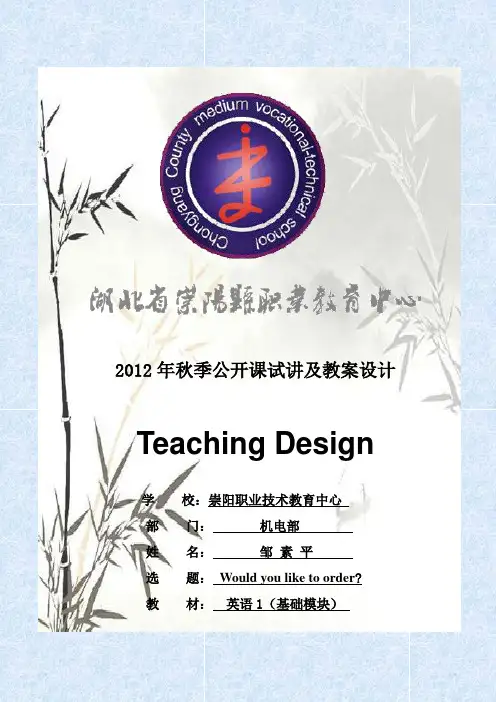
2012年秋季公开课试讲及教案设计Teaching Design学校:崇阳职业技术教育中心部门:机电部*名:***选题:Would you like to order?教材:英语1(基础模块)1.Teaching aims1.1 Knowledge aims: learning the vocabulary and structures of this unit 1.1.1 Vocabularymanager, fork, menu, customer, chopsticks, juice, coffee, beef and so on1.1.2 Grammar focusthe Comparative and Superlative form of adjectives1.2 Ability aims1.2.1 Ss are able to describe and compare different things both in written and oralEnglish;1.2.2 Ss are able to classify words about restaurant and write down the menu.1.2.3 Ss are able to improve comprehensive skills through tasks1.3 Emotional aimsSs are able to take an active part in cooperation with teammates to finish tasks;Ss are able to make choice through comparison2. Teaching key pointsGeneralizing the rules of the Comparatives and Superlatives; consolidate the words in this unit in specific context3. Possible difficultyGetting familiar with Comparatives and Superlatives according to pictures;4. Teaching and learning methods4.1 teaching methodscommunicative teaching methodaudio-visual method4.2 learning methodscommunicative strategyresource strategy5. Teaching toolsMulti-media; PPT; chalks6. Teaching proceduresStep One Review & Lead inFirst teacher will brainstorm students with a video to help them have a review what have been learnt before, and then shows two pictures to lead in the topic of this lesson.Step Two Grammar focus1.Recognize the rulesTeacher classifies in advance the table on Page 95 into five sections according to the five regular changing rules. In order to cultivate students’interest, teacher plays a cliff video. And then teacher shows tables respectively to let students generalize the rules of the different degrees of adjectives: Positive degree, Comparative degree and Superlative degree. Then teacher summarizes the usage of adjective degrees.(说明:以一个视频片段引起学生学习兴趣。
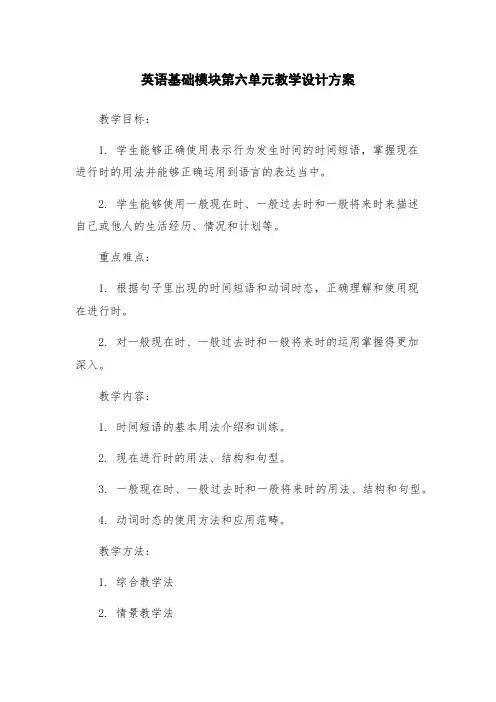
英语基础模块第六单元教学设计方案教学目标:1. 学生能够正确使用表示行为发生时间的时间短语,掌握现在进行时的用法并能够正确运用到语言的表达当中。
2. 学生能够使用一般现在时、一般过去时和一般将来时来描述自己或他人的生活经历、情况和计划等。
重点难点:1. 根据句子里出现的时间短语和动词时态,正确理解和使用现在进行时。
2. 对一般现在时、一般过去时和一般将来时的运用掌握得更加深入。
教学内容:1. 时间短语的基本用法介绍和训练。
2. 现在进行时的用法、结构和句型。
3. 一般现在时、一般过去时和一般将来时的用法、结构和句型。
4. 动词时态的使用方法和应用范畴。
教学方法:1. 综合教学法2. 情景教学法3. 任务型教学法教学手段:1. 讲解演示法2. 课件演示法3. 视频教学法4. 实物展示和图片展示法教学过程:一、导入阶段(10分钟)引导学生关注时间和时间短语的使用,以此为引子展开教学。
二、讲解阶段(30分钟)1. 时间短语的基本用法A. 一些日常用语:breakfast(早餐)、lunch(午餐)、dinner(晚餐)、time(时间)、now(现在)、tomorrow(明天)、yesterday(昨天)、weekend(周末)、afternoon(下午)、evening(晚上)等等。
B. 介绍时间短语与动词时态的搭配关系,如:现在进行时:正在进行的行为一般现在时:经常或习惯性的行为一般过去时:过去某个时间点发生的行为一般将来时:将来某个时间点将要发生的行为2. 现在进行时的用法、结构和句型A. 现在进行时的用法:表示正在进行的行为B. 现在进行时的结构:主语+be动词(is/am/are)+现在分词(-ing)C. 现在进行时的句型:主语+be动词+现在分词+其他补充信息D. 现在进行时的正确运用3. 一般现在时、一般过去时和一般将来时的用法、结构和句型A. 一般现在时的用法:描述经常或习惯性的行为B. 一般过去时的用法:描述过去某个时间点发生的行为C. 一般将来时的用法:描述将来某个时间点将要发生的行为D. 三个时态的结构和句型E. 三个时态的正确运用三、实践阶段(40分钟)1. 给学生进行一个小组任务,要求他们利用所学的时间短语和各种动词时态描述自己或他人的生活经历、情况和计划。
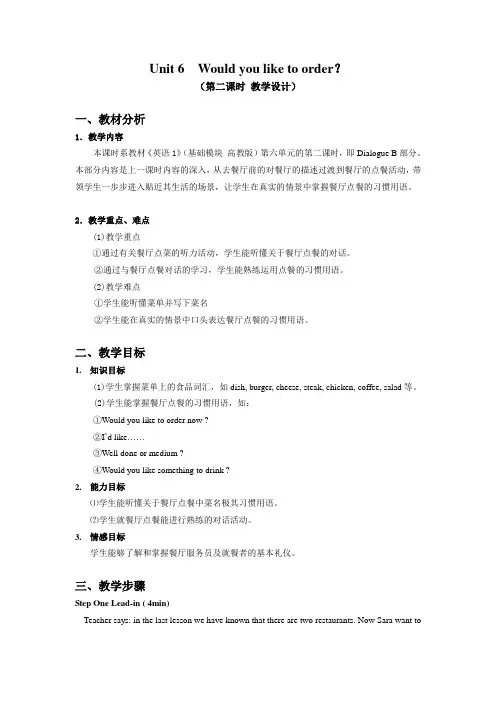
Unit 6 Would you like to order?(第二课时教学设计)一、教材分析1.教学内容本课时系教材《英语1》(基础模块高教版)第六单元的第二课时,即Dialogue B部分。
本部分内容是上一课时内容的深入,从去餐厅前的对餐厅的描述过渡到餐厅的点餐活动,带领学生一步步进入贴近其生活的场景,让学生在真实的情景中掌握餐厅点餐的习惯用语。
2.教学重点、难点(1)教学重点①通过有关餐厅点菜的听力活动,学生能听懂关于餐厅点餐的对话。
②通过与餐厅点餐对话的学习,学生能熟练运用点餐的习惯用语。
(2)教学难点①学生能听懂菜单并写下菜名②学生能在真实的情景中口头表达餐厅点餐的习惯用语。
二、教学目标1.知识目标(1)学生掌握菜单上的食品词汇,如dish, burger, cheese, steak, chicken, coffee, salad等。
(2)学生能掌握餐厅点餐的习惯用语,如:①Would you like to order now ?②I’d like……③Well done or medium ?④Would you like something to drink ?2.能力目标⑴学生能听懂关于餐厅点餐中菜名极其习惯用语。
⑵学生就餐厅点餐能进行熟练的对话活动。
3.情感目标学生能够了解和掌握餐厅服务员及就餐者的基本礼仪。
三、教学步骤Step One Lead-in ( 4min)Teacher says: in the last lesson we have known that there are two restaurants. Now Sara want togo Meiwei Restaurant. Let’s step into Meiwei restaurants with her together to order something to eat or drink today. But do you knowHow should have behavior as a customer?How should a waiter/waitree should behavior?Students work in the groups to discuss to get the right answers to the above two questions.(设计意图: 教师从上一节课内容直接过渡到本节课,开门见山。
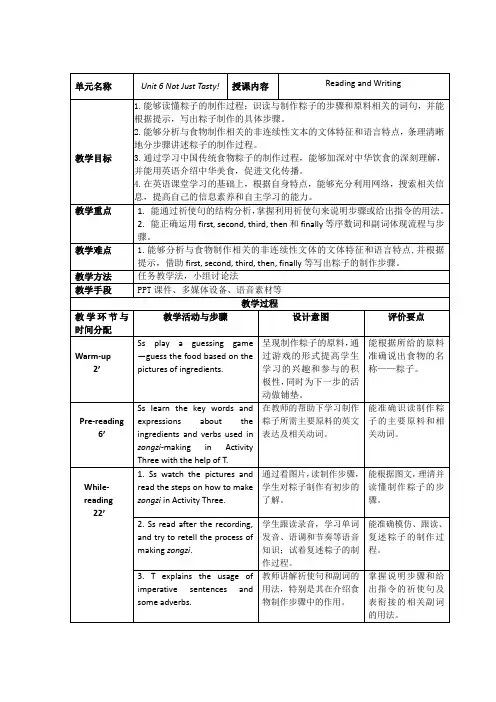
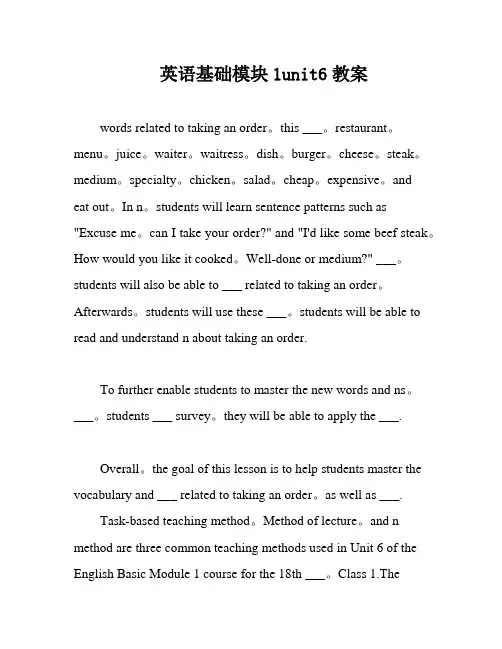
英语基础模块1unit6教案words related to taking an order。
this ___。
restaurant。
menu。
juice。
waiter。
waitress。
dish。
burger。
cheese。
steak。
medium。
specialty。
chicken。
salad。
cheap。
expensive。
andeat out。
In n。
students will learn sentence patterns such as "Excuse me。
can I take your order?" and "I'd like some beef steak。
How would you like it cooked。
Well-done or medium?" ___。
students will also be able to ___ related to taking an order。
Afterwards。
students will use these ___。
students will be able to read and understand n about taking an order.To further enable students to master the new words and ns。
___。
students ___ survey。
they will be able to apply the ___.Overall。
the goal of this lesson is to help students master the vocabulary and ___ related to taking an order。
as well as ___.Task-based teaching method。
Method of lecture。
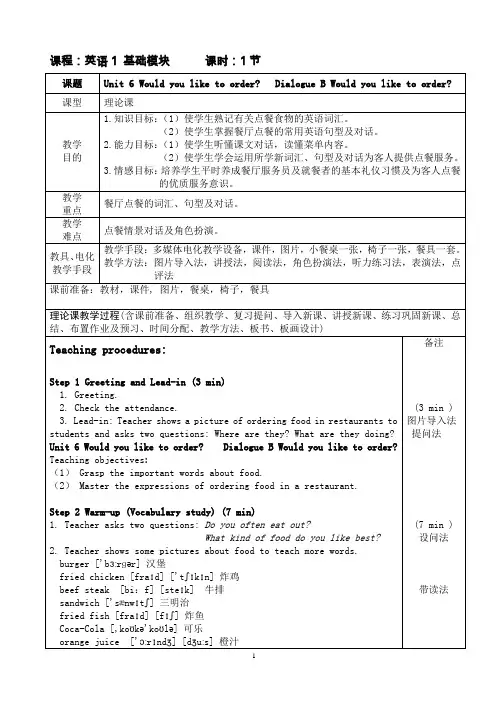
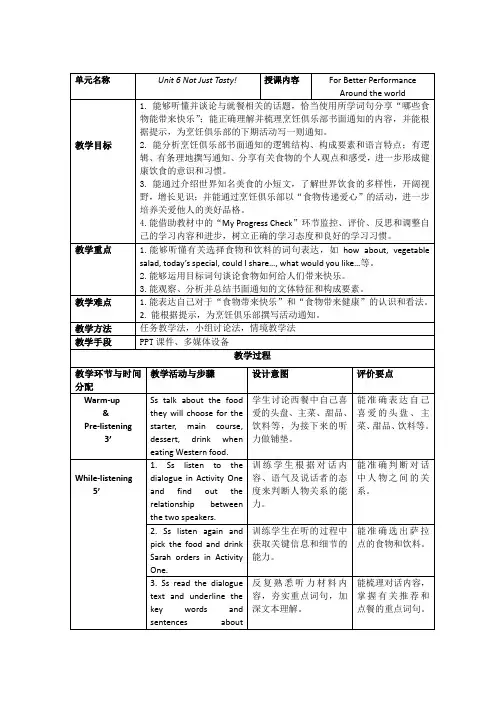

中职英语基础模块1 教学设计(教案、学案)Unit 6 第三课时Unit 6 Would you like to order?(第三课时 教学设计)一、教材分析1.教学内容本课时系教材《英语1》(基础模块 高教版)第六单元的第三课时,即reading and writing 部分。
本部分的主要活动是读懂菜单,在前两课时的基础上,学生已经了解了一些菜名,本部分内容要求学生通过就菜品的价格用英语进行比较,从而让学生学会在口头和书面表达中正确运用形容词比较级和最高级比较事物,进一步增加学生的学习词汇以及增强学生实际运用语言的能力。
2.教学重点、难点(1)教学重点①通过阅读菜单和表格,学生能总结并掌握形容词比较级和最高级的变化规律。
②学生能在口头及书面表达中正确运用形容词比较级和最高级比较不同餐厅③学生能根据阅读材料,纠正错误信息的表达。
(2)教学难点①学生通过文中给出的线索,猜出词义②学生能够运用阅读表格的策略对餐厅进行比较二、教学目标1.知识目标(1)学生能理解并运用形容餐厅的词汇 如,delicious, cheap,expensive 等(2)学生能够正确运用形容词比较级和最高级比较各餐厅情况2.能力目标(1)学生能够读懂菜单,并通过文中给出的线索,猜出词义,归纳形容词比较级和最高级规律。
(2)学生能够运用形容词的比较级和最高级以书面形式简单介绍餐厅的基本情况,如路程远近,饭菜价格及质量。
3.情感目标通过对餐厅的比较,学生外出就餐时能做出理智选择。
三、教学步骤Step One Lead-in (1min)Teacher shows the situation: If you invite your friend to Meiwei Restaurant to eat out, Whatwould you like to order for your friend ?(设计意图:教师设定情境,让学生想象邀请朋友用餐。
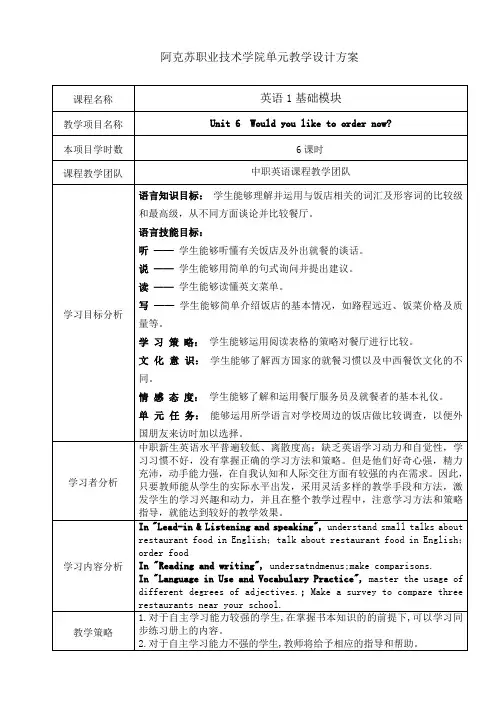
阿克苏职业技术学院单元教学设计方案教学过程设计(II)(按照两课时的教学内容任务编写)教学过程设计(III)(按照两课时的教学内容任务编写)后记:步骤教学内容时间分配明确任务Vocabulary Practice and Unit task 通过在具体语境中使用和练习词汇,学生能够巩固本单元重点词汇;通过完成单元任务即请一个美国朋友到一家合适的餐厅吃饭,提高学生综合运用语言的能力;根据图片情景,学生能正确并熟练使用形容词比较级和最高级;学生能够运用本单元的所学语言完成一个真实的任务,即请一个美国朋友到一家合适的餐厅吃饭。
5’项目引导1.Let students look at the table on page 95 and try to generalizethe rules of the different degrees of adjectives: Positivedegree, Comparative degree and Superlative degree. Then teachersummarizes the usage of adjective degrees.2.Lead-in the new class10’知识讲解⑴本单元关于请外国朋友到餐厅吃饭所涉及的关键句型及其运用情景。
⑵能掌握音标//, / e /, //, //, / /,/k/,/g/以及相关的字母、字母组合。
⑶具备总结分析本单元关于请外国朋友到餐厅吃饭所涉及的句型功能及其运用情景的能力。
⑷学生能在日常交流中正确使用形容词比较级。
⑸学生掌握正确的音标学习策略。
25’操作训练Activity14. Look and complete.Activity 15. Talk and guess.Acticity 16. Look and complete.30’知识深化Pronunciation practice Students murmur the chant after thetape in the first time. In the second time students read after15’//, / e /, //, //, / /,/k/,/g/.Unit task: Make a survey to compare three restaurants near your school.归纳总结通过本单元的学习,学生能够掌握形容词比较级和最高级的用法、与餐厅有关词汇的巩固以及单元任务,即对学校周边的餐厅做比较调查,以便外国朋友来访时加以选择。
教案(2)总第6-1-2课时一、复习旧知二、导入新课三、讲授新知一、复习旧知(时间分配:3mins)Long time no see, class! I miss you so much.How’s your winter vacation?How’s your Spring Festival? Are you happy?Now let’s check your homework.二、导入新课(时间分配:3mins)Brainstorm: suppose that you will eat out with your family at dinner. Which food would you like to order?Main food: rice , steamed buns, noodlesMain dish:tomato, potato, cabbage, fish, steakDrinks: apple juice, pear juice, lemon juice with ice...三、讲授新课(时间分配:)Activity1 read and tickPair work: read the words below, discuss and tick out words involving restaurant.Food, menu, juice, ball, teacher, book, chicken, fish, tomato, waiter, delicious, manager, waitress, cloudy, beef...Then check the answer.Activity 2 Look and complete.Pair work: look at the pictures below and then complete the sentences.Listening and speakingActivity3 look at picture and choose the sentence that the service should say.The waiter might say:( ) a. Hello! Nice to see you!( ) b. Welcome to Meiwei Restaurant!The waiter might say:( ) a. Can I take your order?( ) b. What’s your favorite food?Check the answer.Activity 4. Listen and match.Listen to the tape and match them.HotdogsandwichHamburger a ham sandwich DialogueWaiter: Excuse me, can I take your order?Woman: Yes, I’d like a burger.Waiter: A cheese burger or a chicken burger?Woman: Which is smaller?Waiter: The chicken burger is smaller.Woman: Well, I’d like a chicken burger.Waiter: Would you like something to drink?Woman: Yes, a cup of coffee.Waiter: All right. What about you, sir?Man: I’d like a hotdog and a glass of orange juice.Waiter: OK. Wait a minute, please.Answer:Woman: a chicken burgerMan: a hotdogActivity 5 Listen and complete.Listen to the tape and tick out the drinks that they order. Woman: a cup of coffeeMan: a glass of orange juiceActivity 6 Listen, read and underline.Listen to the tape, read the dialogue and underline the sentences that used in taking an order.Waiter: Excuse me, can I take your order?Sara: Yes. I’d like some beef steak.Waiter: How would you like it cooked? Well-done or medium? Sara: Which is better?Waiter: Medium is better, it's our specialty.Sara: Well, medium, please.Waiter: Would you like a side salad?Sara: Yes, the tomato and onion salad, please.Waiter: Anything to drink?Sara: Yes, a glass of orange juice.Waiter: All right, wait a minute, please.Language points presentationWould you like something to drink?您想喝点什么?Would you like...? 这里意为“你想要...吗?”Eg. Would you like an apple? 想吃个苹果吗?Would you like some noodles?想来点儿面条吗?Pair work: talk about the answers with your partner. Activity 7. Act and practice.Pair work: practice and act the dialogue with their partner. Can I take your order? What would you like to eat / drink?I’d like ...Would you like ...? Yes, please. / No, thanks.What about you? I’d like ... / I’ll have the same.FoodsSteak dumplingsnoodlesSaladHamburger四、难点梳理五、课堂实DrinksOrange juice Coca-cola teaMilk coffeeChoose two of them to show themselves in front of class. Activity 8 talk and complete.Date: table: guest number: Dish Amount MemoTotal: Thank you!Pair work: talk about the table and then make a menu. Everyday English—Do you have a reservation?您有预定吗?—Yes. The reservation is under Mr Li.是的,是以李先生的名字预订的。
高教版英语基础模块1 Unit 6 Would you like to order教学设计1.XXX XXX2.Students repeat the words after the XXX。
3.XXX provides examples of how to use the vocabulary in a sentence。
4.XXX。
XXX:1) XXX.2) XXX.Step 3 n (Dialogue) (10 min)1.XXX plays the。
of the dialogue "Would you like to order?"2.Students listen to the dialogue and follow along with the transcript on the screen。
3.XXX。
4.XXX。
XXX:1) Understand the dialogue "Would you like to order?"2) Learn new words and phrases from the dialogue。
Step 4 Practice (Role-play) (15 min)1.XXX to students to act out the dialogue "Would you like to order?"2.XXX。
3.XXX provides XXX。
4.XXX。
XXX:1) Practice using XXX-play。
2) XXX-play。
Step 5 Review and Summary (5 min)1.XXX asks students to summarize what they have XXX。
2.XXX3.XXX provides XXX。
XXX:1) Review key points from the lesson。
中职英语基础模块1unit 6table manners教案中职英语基础模块1 unit 6 "Table Manners" 教案教学目标1. 知识目标:学生能够掌握与餐桌礼仪相关的基本词汇和表达方式。
2. 能力目标:学生能够在实际情境中运用所学知识,进行简单的餐桌礼仪对话。
3. 情感目标:培养学生对餐桌礼仪的重视,增强跨文化交流的意识。
教学内容1. 与餐桌礼仪相关的基本词汇。
2. 餐桌礼仪的基本规则与习惯。
3. 与餐桌礼仪相关的实用对话。
教学难点与重点重点:餐桌礼仪的基本规则与习惯。
难点:在实际情境中运用餐桌礼仪进行交流。
解决办法:通过角色扮演、模拟场景等形式,帮助学生实际运用所学知识。
教具和多媒体资源黑板:用于书写重点词汇和句型。
投影仪:播放与餐桌礼仪相关的图片和视频。
教学软件:模拟真实情境,进行角色扮演练习。
教学方法1. 激活学生的前知:回顾已学过的中西餐桌礼仪的差异。
2. 教学策略:讲解、示范、小组讨论、角色扮演。
3. 学生活动:小组合作,模拟真实情境进行对话练习。
教学过程1. 导入:提问导入,询问学生关于餐桌礼仪的了解,激起学生的兴趣。
2. 讲授新课:讲解与餐桌礼仪相关的词汇和表达方式,介绍不同文化背景下的餐桌礼仪规则与习惯。
3. 巩固练习:分组进行角色扮演,模拟真实情境进行对话练习,如预定餐厅、点餐、用餐等环节。
4. 归纳小结:总结本节课的重点内容,强调餐桌礼仪在实际交流中的重要性。
评价与反馈1. 设计评价策略:小组报告、观察、口头反馈。
2. 反馈:为学生提供具体的反馈意见,指导他们如何改进在角色扮演中的表现。
作业布置1. 熟记本节课所学的词汇和表达方式。
2. 与同伴合作,模拟一个餐厅用餐的场景,编写一段对话并进行练习。
3. 搜集一种自己感兴趣的餐桌礼仪,并进行简单的介绍。
英语基础模块上册第六单元教案课题Unit 6Go Out and Enjoy life! 课型Newlyteaching授课日期授课时数 6教学目标1.Ask for and give directions.2.Talk about an interesting place.3.Explore your city or town.教学重点1. Train the students’ listening ability by listening practice.2. Train the students’speaking ability by greetings and introductions.教学难点1. How to improve the students’ listening ability.2. How to help students finish the task of speaking.学情分析Some students have difficulty understanding the language points.更新、补充删节内容Add some word explanation and some language points.使用教具Tape recorder, blackboard, multimedia教学方法与教学手段Practice listening, speaking, reading, writing, translating, etc.课题Warm up ,listeningand speaking A课型New 授课日期授课数 1教学目标1.To master some words and expressions:hang out mall prefer somewhere quiet subway next to on one’s left2.To listen to the dialogue and finish the exercises.3.To do some speaking about places and directions.4.To be willing to communicate with others in English.教学重点1. Train the students’ listening ability by listening practice.2. Train the students’speaking ability by greetings and introductions.教学难点1. How to improve the students’ listening ability.2. How to help students finish the task of speaking.学情分析Many students are not good at learning English. They have difficulty in listening, speaking and reading. The teacher should spend more time in helping them.教学用具 1. a multimedia 2.a tape recorder 3.the blackboard 教学方法与手段1. Warming up to arouse the students’ interest in directions.2. Listening-and-answering activity to help the students go through the listening material.3. Individual, pair or group work to make every student work教学程序师生活动Step1. Greetings and introductions.Hello, everyone. My name is ….Step2. Free talk.What do you usually do at the weekends?Where do you like to go?Step3. Warm-up.1.Read and learn the new words.2.Match the pictures with the correct words from the box.3.Put the food from Activity one into the correct circles.4.Talk about some places you like to go.Step4. Listening and Speaking AWhere can I hang out?1.Look at the picture and guess how Billy will get to the citylibrary. Then listen to the conversation to check yourprediction.2.Then close your books and listen to the conversation tocheck your prediction.3.Listen again and then underline the expressions aboutasking for and giving directions in the conversation.4.Read the dialogue after the tape to practise pronunciationand tone.5.Act out the dialogue./doc/d5dd7a8e83d049649b6658d2.ht ml eful expressions.7.Talk about asking for directions with the expressionsyou’ve learned.8.Work in pairs and complete the conversation below.Step5. Sum-up and consolidation.( From Workbook Part A)1.Listen to five conversations and answer the questions.2.Listen to a long conversation and answer the questions.Step6. Homework. Finish Workbook Part A .课题Listening andspeaking B课型New 授课日期授课时数1教学目标1.To master some words and expressions:Brandon beach Miami Florida relax area ocean2.To listen to the dialogue and finish the exercises.3.To do some speaking about the main reason that peoplelike the place.4.To be willing to communicate with others in English.教学重点1. Train the students’ listening ability by listening practice.2. Train the students’ speaking ability by introducingthe favourite place.教学难点1. How to improve the students’ listening ability.2. How to help students finish the task of speaking.学情分析Many students are not good at learning English. They have difficulty in speaking. The teacher should spend more time in helping them.教学用具 1. a multimedia 2.a tape recorder 3.the blackboard 教学方法与手段1. Warming up to arouse the students’ interest in science.2. Listening-and-answering activity to help the students go through the listening material.3. Individual, pair or group work to make every student work in class.教学程序师生活动Step1. Greetings and introductions.Step2. Revision.Do you know how to get to ...?Could you tell me the way to...?Where is the...?I’m wondering how to get to...?Step3. Learn something about places. Which of the attractions below do you prefer?Step4. Learn the new words.Brandon beach Miami Florida relax area oceanStep5. Listen and circle the best answer.Step6. Listen again and choose the correct verbs to fill inthe blanks.Step7. Consolidation.(From workbook P18 )1.Listen to five conversations and answer thequestions.2.Listen to a long conversation and answer thequestions.Step9. Sum-up and homeworkFinish Workbook .课题Reading and writing 课型New 授课日期授课时数 2教学目标1.To go over the key words and expressions:fountain square peaceful lively noisy bench bush surround nursery stress sweet downtown charming2. To read and comprehend the text.3. To grasp some language points.4. To be willing to communicate with others in English.教学重点 1. Master the following phrases and sentence pattern: far away be tired of most of all2. Enable the students to understand the text better.3. Improve the students’ reading ability.教学难点 1. How to make the students understand the reading text better.2. How to make the students understand the following sentence.学情分析Many students are not good at learning English. They have difficulty in reading. The teacher should spend more time in helping them.教学用具 1. a multimedia 2.a tape recorder 3.the blackboard 教学方法与手段1. Scanning the text to get some information.2. Careful reading to answer some detailed questions.3. Discussion after reading the passage to make the students learn how to use the scientific method to solve the problem.4. Individual, pair or group work to make every student work in class.教学程序师生活动Step1. Greetings and introductions.Step2. Free talk.Step3. Lead-in.Is there any square in your town?Do you like to go there?Step4. Skim the text and try to catch the main idea.Why do I love the fountain square in my city?Step5. Scan for the specific information and finish task2.3.4Step6. Language points.1. It has a fountain in the middle and there are a few benches to sit on, but not many people go there.在广场中间有一个喷泉,还有一些可座的长椅。
阿克苏职业技术学院单元教学设计方案
II
教学过程设计(III)(按照两课时的教学内容任务编写)
步骤教学内容时间分配明确
任务
Vocabulary Practice and Unit task 通过在具体语境中使用和
练习词汇,学生能够巩固本单元重点词汇;通过完成单元任务即
请一个美国朋友到一家合适的餐厅吃饭,提高学生综合运用语
言的能力;根据图片情景,学生能正确并熟练使用形容词比较级
和最高级;学生能够运用本单元的所学语言完成一个真实的任
务,即请一个美国朋友到一家合适的餐厅吃饭。
5’
项目引导1.Let students look at the table on page 95 and try to generalize the rules of
the different degrees of adjectives: Positive degree, Comparative degree and Superlative degree. Then teacher summarizes the usage of adjective
degrees.
2.Lead-in the new class
10’
知识讲解⑴本单元关于请外国朋友到餐厅吃饭所涉及的关键句型及其
运用情景。
⑵能掌握音标//, / e /, //, //, //,/k/,/g/以及相关的字母、
字母组合。
⑶具备总结分析本单元关于请外国朋友到餐厅吃饭所涉及的
句型功能及其运用情景的能力。
⑷学生能在日常交流中正确使用形容词比较级。
⑸学生掌握正确的音标学习策略。
25’
操作训练Activity14. Look and complete.
Activity 15. Talk and guess.
Acticity 16. Look and complete.
30’
知识深化Pronunciation practice Students murmur the chant after the tape in the first
time. In the second time students read after the tape loudly and pay special
attention to the words with the pronunciation of//, / e /, //, //, //,
/k/,/g/.
Unit task: Make a survey to compare three restaurants near your school.
15’
归纳总结通过本单元的学习,学生能够掌握形容词比较级和最高级的用
法、与餐厅有关词汇的巩固以及单元任务,即对学校周边的餐
厅做比较调查,以便外国朋友来访时加以选择。
这些内容总结
了本单元的重要词汇和语法,并在完成真实的任务中达到综合
运用本单元所学语言的能力。
3’
作业布置1. Recite the new words of this unit.2. Finish all the exercises in
this section.3. Prepare for the next unit.
2’
课后体会
21 / 21。